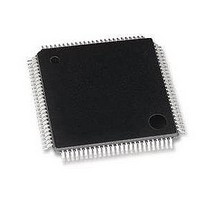LAN9118-MD SMSC, LAN9118-MD Datasheet - Page 62

LAN9118-MD
Manufacturer Part Number
LAN9118-MD
Description
Ethernet ICs HiPerfrm Sngl-Chip 10/100 Ethrnt
Manufacturer
SMSC
Type
Single Chip MAC and PHYr
Datasheet
1.LAN9118-MT.pdf
(132 pages)
Specifications of LAN9118-MD
Ethernet Connection Type
10 Base-T, 100 Base-TX
Minimum Operating Temperature
0 C
Mounting Style
SMD/SMT
Product
Ethernet Controllers
Number Of Transceivers
1
Standard Supported
802.3
Data Rate
10 MB, 100 MB
Supply Voltage (max)
3.3 V
Supply Voltage (min)
0 V
Maximum Operating Temperature
+ 70 C
Package / Case
TQFP-100
Lead Free Status / RoHS Status
Lead free / RoHS Compliant
Revision 1.5 (07-11-08)
4.4.3
4.5
4.5.1
4.5.2
4.5.3
4.6
(TX_EN is low), the TX10M block outputs Normal Link Pulses (NLPs) to maintain communications with
the remote link partner.
10M Transmit Drivers
The Manchester encoded data is sent to the analog transmitter where it is shaped and filtered before
being driven out as a differential signal across the TXP and TXN outputs.
The 10Base-T receiver gets the Manchester- encoded analog signal from the cable via the magnetics.
It recovers the receive clock from the signal and uses this clock to recover the NRZI data stream. This
10M serial data is converted to 4-bit data nibbles which are passed to the controller across the MII at
a rate of 2.5MHz.
This 10M receiver uses the following blocks:
10M Receive Input and Squelch
The Manchester signal from the cable is fed into the PHY (on inputs RXP and RXN) via 1:1 ratio
magnetics. It is first filtered to reduce any out-of-band noise. It then passes through a SQUELCH
circuit. The SQUELCH is a set of amplitude and timing comparators that normally reject differential
voltage levels below 300mV and detect and recognize differential voltages above 585mV.
Manchester Decoding
The output of the SQUELCH goes to the RX10M block where it is validated as Manchester encoded
data. The polarity of the signal is also checked. If the polarity is reversed (local RXP is connected to
RXN of the remote partner and vice versa), then this is identified and corrected. The reversed condition
is indicated by the flag “XPOL“, bit 4 in register 27. The 10M PLL is locked onto the received
Manchester signal and from this, generates the received 20MHz clock. Using this clock, the
Manchester encoded data is extracted and converted to a 10MHz NRZI data stream. It is then
converted from serial to 4-bit wide parallel data.
The RX10M block also detects valid 10Base-T IDLE signals - Normal Link Pulses (NLPs) - to maintain
the link.
Jabber Detection
Jabber is a condition in which a station transmits for a period of time longer than the maximum
permissible packet length, usually due to a fault condition, that results in holding the TX_EN input for
a long period. Special logic is used to detect the jabber state and abort the transmission to the line,
within 45ms. Once TX_EN is deasserted, the logic resets the jabber condition.
The purpose of the Auto-negotiation function is to automatically configure the PHY to the optimum link
parameters based on the capabilities of its link partner. Auto-negotiation is a mechanism for
exchanging configuration information between two link-partners and automatically selecting the highest
performance mode of operation supported by both sides. Auto-negotiation is fully defined in clause 28
of the IEEE 802.3 specification.
10Base-T Receive
Auto-negotiation
Filter and SQUELCH (analog)
10M PLL (analog)
RX 10M (digital)
MII (digital)
DATASHEET
62
High Performance Single-Chip 10/100 Non-PCI Ethernet Controller
SMSC LAN9118
Datasheet













